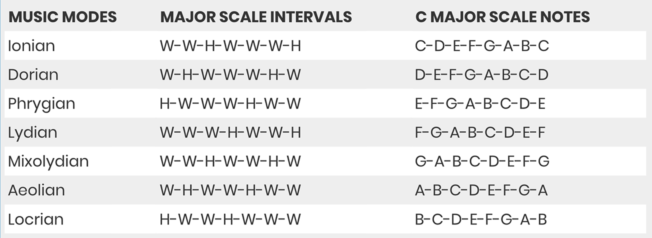What are music modes? Michael Emenau explains the musical theory behind modes, how to construct them, and how they differ from regular scales. He also shares tips for using modes in your music.

What are Music Modes?
Music modes are a type of scale which like major and minor scales, contains seven notes. However, music modes provide alternative tonalities by starting and ending a scale on different notes. They are variations of musical scales that give various emotions and feelings.
There are seven musical modes: Ionian, Dorian, Phrygian, Lydian, Mixolydian, Aeolian, and Locrian . These modes are constructed from the seven scale degrees of a major scale. This means they use the same interval pattern as a major scale. The difference is the tonic (the root note) and the sequence of half steps and whole steps. These different starting positions give each mode a unique musical character.
Note : Scale degrees describe the different notes of a scale in relation to each other and their distance from the tonic (first note of the scale).
Why Bother with Music Modes?
Music modes give you more emotional options than the standard major and minor dichotomy of happy or sad. What’s great about experimenting with different modes is it immediately changes the feeling and flavour of your music.
Changing the mode also allows you to emphasize different notes of the scale. This note emphasis is where the difference and the “flavour” of modes lie. Consider trying modes to introduce new tonalities, variety, and vibe into your music. For example, modes can evoke emotion by sounding dark, bright, happy, sad, tense, heavenly, epic, or other perceived characteristics.
Let’s have a closer look at the seven music modes to get a better understanding of their unique musical character.
Musical Modes Explained
The C major scale is the best example when learning music modes. Sticking to only the white keys on a keyboard can make things easier to follow.
The C major scale has the notes C-D-E-F-G-A-B-C . The seven notes in all major scales follow the same interval pattern of half steps and whole steps, which is W-W-H-W-W-W-H (Whole-Whole-Half-Whole-Whole-Whole-Half). Moreover, all seven modes use this major scale interval pattern to build each scale.

The examples below show each mode starting from one of the seven scale degrees in a C major scale. The difference is the tonic note (the root note) and the sequence of intervals between the notes. Notice how the tonic note and interval pattern rotate between each mode.

Ionian Mode
The Ionian mode is the same as a major scale. It starts on the 1st scale degree and has the same succession of whole and half steps as a major scale. This mode also has a bright, uplifting, and happy sound.
W-W-H-W-W-W-H
C-D-E-F-G-A-B-C
Dorian Mode
The Dorian mode starts on the 2nd scale degree of the major scale. It’s similar to a natural minor scale. However, the raised 6th scale degree makes this mode sound brighter and more uplifting than a typical minor scale.
W-H-W-W-W-H-W
D-E-F-G-A-B-C-D
Phrygian Mode
The Phrygian mode starts on the 3rd scale degree of the major scale. It’s similar to a natural minor scale. However, the lowered 2nd scale degree gives this mode a much darker and tense flavour than a typical minor scale.
H-W-W-W-H-W-W
E-F-G-A-B-C-D-E
Lydian Mode
The Lydian mode starts on the 4th scale degree of the major scale. It’s similar to a major scale. However, the raised 4th scale degree gives this mode a much brighter, heavenly feel than a typical major scale.
W-W-W-H-W-W-H
F-G-A-B-C-D-E-F
Mixolydian Mode
The Mixolydian mode starts on the 5th scale degree of the major scale. It’s similar to a major scale. However, the lowered 7th scale degree provides a smoother, less happy sound than a typical major scale.
W-W-H-W-W-H-W
G-A-B-C-D-E-F-G
Aeolian Mode
The Aeolian mode is the same as a natural minor scale. It starts on the 6th scale degree of the major scale and has the same interval pattern as a minor scale. This mode also has a sad and oppressive sound.
W-H-W-W-H-W-W
A-B-C-D-E-F-G-A
Locrian Mode
The Locrian mode starts on the 7th scale degree of the major scale. It’s the darkest of all modes. The lowered 5th scale degree creates an unstable and tense sound. It is also the least used mode.
H-W-W-H-W-W-W
B-C-D-E-F-G-A-B
How to Create a Music Mode
Here are two different ways to construct musical modes.
1. Add a Sharp or Flat to a Major Scale
- Ionian : Ionian is the same as a major scale (W-W-H-W-W-W-H)
- Dorian : Lower the 3rd and 7th notes a semitone
- Phrygian : Lower the 2nd, 3rd, 6th, and 7th notes a semitone
- Lydian : Raise the 4th note a semitone
- Mixolydian : Lower the 7th note a semitone
- Aeolian : Lower the 3rd, 6th, and 7th notes a semitone
- Locrian : Lower the 2nd, 3rd, 5th, 6th, and 7th notes a semitone
2. Change the Tonic (Starting Note) of the Major Scale
Build music modes by moving the tonic up or down the seven scale degrees at the start of the scale. For example, the C major scale has the notes C-D-E-F-G-A-B-C. If you use the same notes but start on the 2nd note, which is a ‘D’ note, you will be in Dorian mode (D-E-F-G-A-B-C-D). Using this same logic, you can derive all seven music modes. For example, starting with the 3rd note of the scale = Phrygian, 4th note = Lydian, 5th note = Mixolydian, 6th = Aeolian, and 7th = Locrian.
In this example, we can see that all the modes share the same notes from the C major scale. The only difference is the tonic notes that start the scale. Also, changing the mode allows us to emphasize different notes of the scale.
Using Music Modes to Emphasize Notes
There are certain ways we use scales and modes to define our melodies. The difference between Ionian and Phrygian is not the notes used, but rather the notes being emphasized. For example, the Phrygian mode emphasizes the ‘E’ and ‘B’ notes, which has a different feeling than emphasizing the ‘C’ and ‘G’ notes in Ionian mode. The video below explains the different this concept further:
It’s essential to establish the tonal center for the mode you use in your music, as this gives you the flavour of each mode. This concept is the same as using major and minor scales to evoke a different feeling or flavour.
Below are a few examples of how to establish the tonal center for a melody.
- Focus on the tonic : Doubling the note, repeating it, or using it as a landing note.
- Melody range emphasis : Making the tonic note the highest or lowest in the melody.
- Rhythmic emphasis : Placing the note on downbeats, or sustaining the note for a longer duration.
- Bassline : Have the bass play the tonic or land on the tonic consistently.
Note the unique feeling and flavour each tonal center lends to your composition when constructing them.
This All Sounds like Theory, I Prefer to “Feel” the Music
When writing a piece of music, we inherently choose either strong notes, weak notes, or passing notes depending on the scale and chords. For example, when writing in the key of G major, I will use chords related to that key such as Gmaj, Cmaj, Dmaj, Bmin, etc. I will also use notes for the melody that usually coincides with these chords and then resolve to the tonic. It’s essential to make all your harmony and melody parts work together. So, if you consciously use a different mode, then the melody, chords, and tonal center all need to fit within that mode. It may feel or sound strange at the beginning, but your ears will become accustomed to the different moods of each mode with practice.
Conclusion
Understanding music theory and the different approaches to making music will expand your compositional toolbox. You will have more choices when making your tracks and a better sense of what emotion you want to evoke with your music.
Learning musical modes is also an integral part of music theory that enables aspiring musicians to perfect their craft and expand their creativity. Experiment with these modes, get a feel for the different flavours, and have some fun. And most importantly, if it sounds good, and it gets across the musical idea you are trying to express, then it is right!

Turn your passion for music into a Profession: Learn more about our Music School Programs!
MORE ARTICLES FROM THE ICON BLOG

FIND YOUR SOUND, HONE YOUR CRAFT:
Are you ready to turn music into a career? ICON prepares students to become music producers, composers, performers, recording artists, professional DJs, and entrepreneurs in the entertainment industry. Click below to get information about our award-winning programs:

